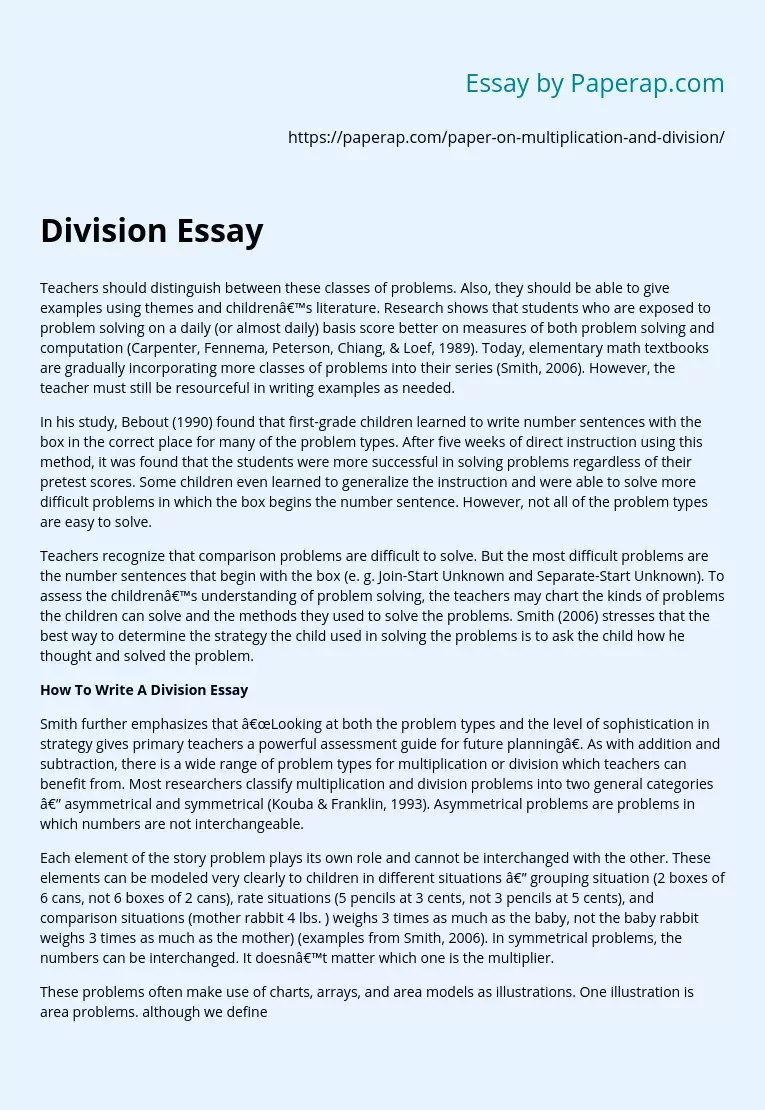Teaching Problem-Solving with Literature Examples
Teachers should distinguish between these classes of problems. Also, they should be able to give examples using themes and children’s literature. Research shows that students who are exposed to problem solving on a daily (or almost daily) basis score better on measures of both problem solving and computation (Carpenter, Fennema, Peterson, Chiang, & Loef, 1989). Today, elementary math textbooks are gradually incorporating more classes of problems into their series (Smith, 2006). However, the teacher must still be resourceful in writing examples as needed.
In his study, Bebout (1990) found that first-grade children learned to write number sentences with the box in the correct place for many of the problem types. After five weeks of direct instruction using this method, it was found that the students were more successful in solving problems regardless of their pretest scores. Some children even learned to generalize the instruction and were able to solve more difficult problems in which the box begins the number sentence. However, not all of the problem types are easy to solve.
Teachers recognize that comparison problems are difficult to solve. But the most difficult problems are the number sentences that begin with the box (e. g. Join-Start Unknown and Separate-Start Unknown). To assess the children’s understanding of problem solving, the teachers may chart the kinds of problems the children can solve and the methods they used to solve the problems. Smith (2006) stresses that the best way to determine the strategy the child used in solving the problems is to ask the child how he thought and solved the problem.
How To Write A Division Essay
Smith further emphasizes that “Looking at both the problem types and the level of sophistication in strategy gives primary teachers a powerful assessment guide for future planning”. As with addition and subtraction, there is a wide range of problem types for multiplication or division which teachers can benefit from. Most researchers classify multiplication and division problems into two general categories — asymmetrical and symmetrical (Kouba & Franklin, 1993). Asymmetrical problems are problems in which numbers are not interchangeable.
Each element of the story problem plays its own role and cannot be interchanged with the other. These elements can be modeled very clearly to children in different situations — grouping situation (2 boxes of 6 cans, not 6 boxes of 2 cans), rate situations (5 pencils at 3 cents, not 3 pencils at 5 cents), and comparison situations (mother rabbit 4 lbs. ) weighs 3 times as much as the baby, not the baby rabbit weighs 3 times as much as the mother) (examples from Smith, 2006). In symmetrical problems, the numbers can be interchanged. It doesn’t matter which one is the multiplier.
These problems often make use of charts, arrays, and area models as illustrations. One illustration is area problems. although we define length as the longer side and the width the shorter side, the sides play similar roles: length ? width = width ? length. Another example is selection problem, also called combination or Cartesian product problems. For example, when calculating sandwich combinations: 3 kinds of bread and 4 fillings, each kind of bread can be matcher to one of 4 fillings or each kind of filling to one of 3 kinds of bread.
Problem types can also be classified through considering what happens in the problem and observing the strategy students use in solving them. This analysis is just an extension of the work on addition and subtraction in the preceding section. Hendrickson (1986) classified these problems into four general categories — change problems, comparison problems, rate problems, and selection problems. As with the categories in addition and subtraction problems, these categories have subtypes depending on which variable is unknown.
To be able to teach children in solving multiplication and division problems, teachers must be familiar with each of these types, their level of difficulty and the strategy used by the children to find a solution. Some are easier than others. As with solving addition and subtraction problems, teachers should evaluate the types of problems their students are able to solve and the strategies they used to solve them. In this paper, we will use the different problem types to find out the level of understanding the children has on the discussion. Each problem will represent one of each type.
Teaching Problem-Solving with Literature Examples. (2019, Dec 05). Retrieved from https://paperap.com/paper-on-multiplication-and-division/

